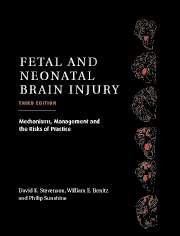Book contents
- Frontmatter
- Contents
- List of contributors
- Foreword
- Preface
- Part I Epidemiology, Pathophysiology, and Pathogenesis of Fetal and Neonatal Brain Injury
- Part II Pregnancy, Labor, and Delivery Complications Causing Brain Injury
- Part III Diagnosis of the Infant with Asphyxia
- 20 Clinical manifestations of hypoxic–ischemic encephalopathy
- 21 The use of the EEG in assessing acute and chronic brain damage in the newborn
- 22 Structural and functional imaging of hypoxic–ischemic injury (HII) in the fetal and neonatal brain
- 23 Near-infrared spectroscopy and imaging
- 24 Placental pathology and the etiology of fetal and neonatal brain injury
- 25 Correlations of clinical, laboratory, imaging and placental findings as to the timing of asphyxial events
- Part IV Specific Conditions Associated with Fetal and Neonatal Brain Injury
- Part V Management of the Depressed or Neurologically Dysfunctional Neonate
- Part VI Assessing the Outcome of the Asphyxiated Infant
- Index
- Plate section
20 - Clinical manifestations of hypoxic–ischemic encephalopathy
from Part III - Diagnosis of the Infant with Asphyxia
Published online by Cambridge University Press: 10 November 2010
- Frontmatter
- Contents
- List of contributors
- Foreword
- Preface
- Part I Epidemiology, Pathophysiology, and Pathogenesis of Fetal and Neonatal Brain Injury
- Part II Pregnancy, Labor, and Delivery Complications Causing Brain Injury
- Part III Diagnosis of the Infant with Asphyxia
- 20 Clinical manifestations of hypoxic–ischemic encephalopathy
- 21 The use of the EEG in assessing acute and chronic brain damage in the newborn
- 22 Structural and functional imaging of hypoxic–ischemic injury (HII) in the fetal and neonatal brain
- 23 Near-infrared spectroscopy and imaging
- 24 Placental pathology and the etiology of fetal and neonatal brain injury
- 25 Correlations of clinical, laboratory, imaging and placental findings as to the timing of asphyxial events
- Part IV Specific Conditions Associated with Fetal and Neonatal Brain Injury
- Part V Management of the Depressed or Neurologically Dysfunctional Neonate
- Part VI Assessing the Outcome of the Asphyxiated Infant
- Index
- Plate section
Summary
Hypoxic–ischemic encephalopathy is a well-recognized clinical syndrome and the most common cause of acute neurological impairment and seizures in the neonatal period. Hypoxic–ischemic brain injury secondary to birth asphyxia can result in the development of “cerebral palsy,” but recent literature has shown that only a small percentage of children with cerebral palsy had intrapartum asphyxia as a possible etiology. More emphasis has been placed on antenatal events as having a greater association with cerebral palsy. Nevertheless, severe hypoxic or ischemic injury during the perinatal period can lead to a neurological syndrome in the newborn period, i.e., hypoxic–ischemic encephalopathy, and subsequent neurological sequelae in the survivors. Therefore, recognizing and understanding hypoxic–ischemic encephalopathy are important. The clinical features, the management, and the clinicopathologic syndromes of hypoxic–ischemic encephalopathy are presented in this chapter.
Clinical features and management
The clinical features in the infant with hypoxic–ischemic encephalopathy are presented here by first describing a general approach to the evaluation. Then the specific clinical features, diagnostic studies, prognosis, and management of these infants are described.
General evaluation
The initial assessment of the infant with suspected hypoxic–ischemic encephalopathy relies on obtaining a thorough history and carrying out a careful physical examination. The history should be directed toward determining whether there were any specific antenatal factors that might account for the disorder. Review of the maternal history, fetal monitoring studies, fetal ultrasonographic findings, and fetal acid–base measurements is essential.
- Type
- Chapter
- Information
- Fetal and Neonatal Brain InjuryMechanisms, Management and the Risks of Practice, pp. 411 - 424Publisher: Cambridge University PressPrint publication year: 2003
- 1
- Cited by



